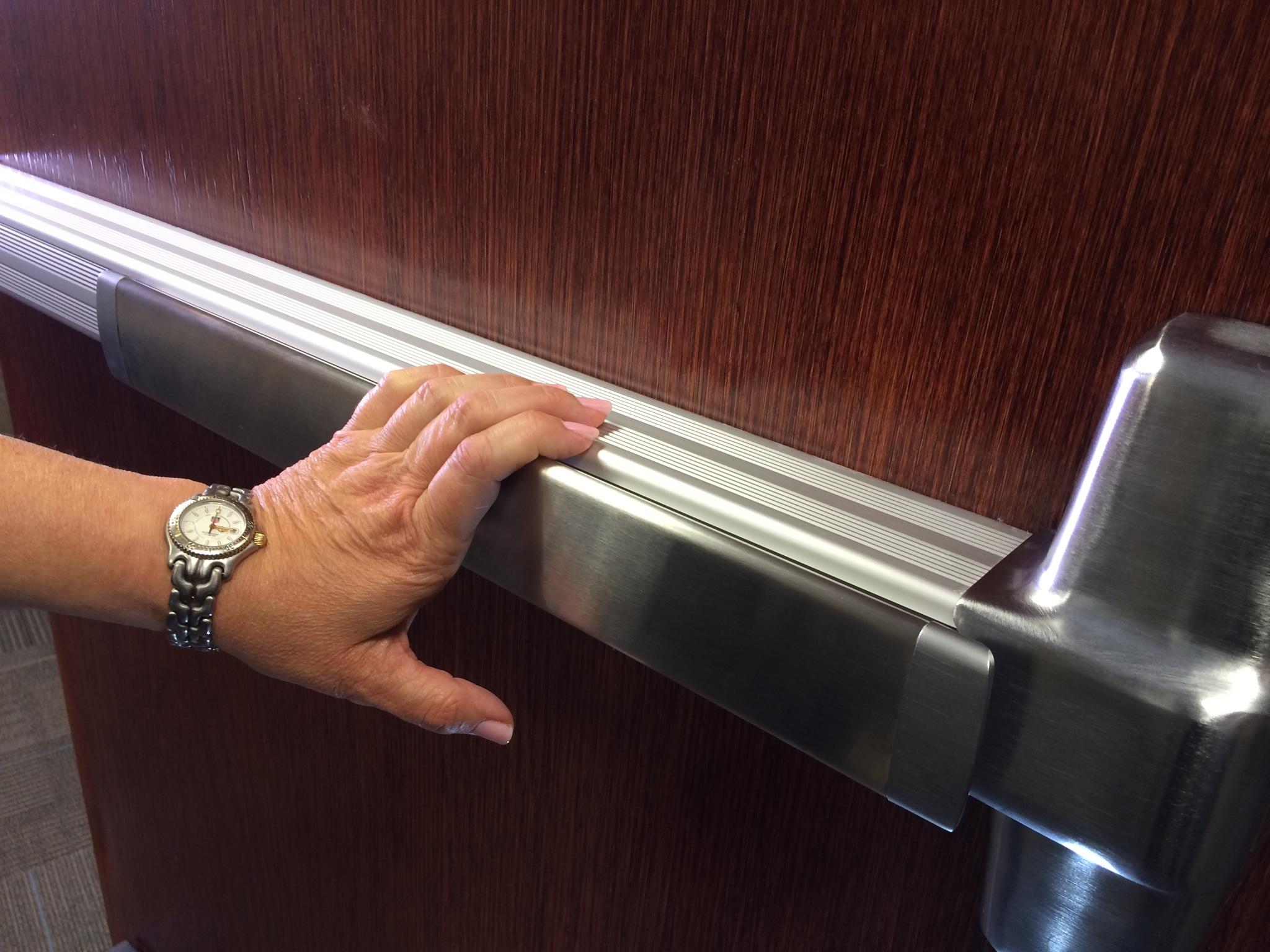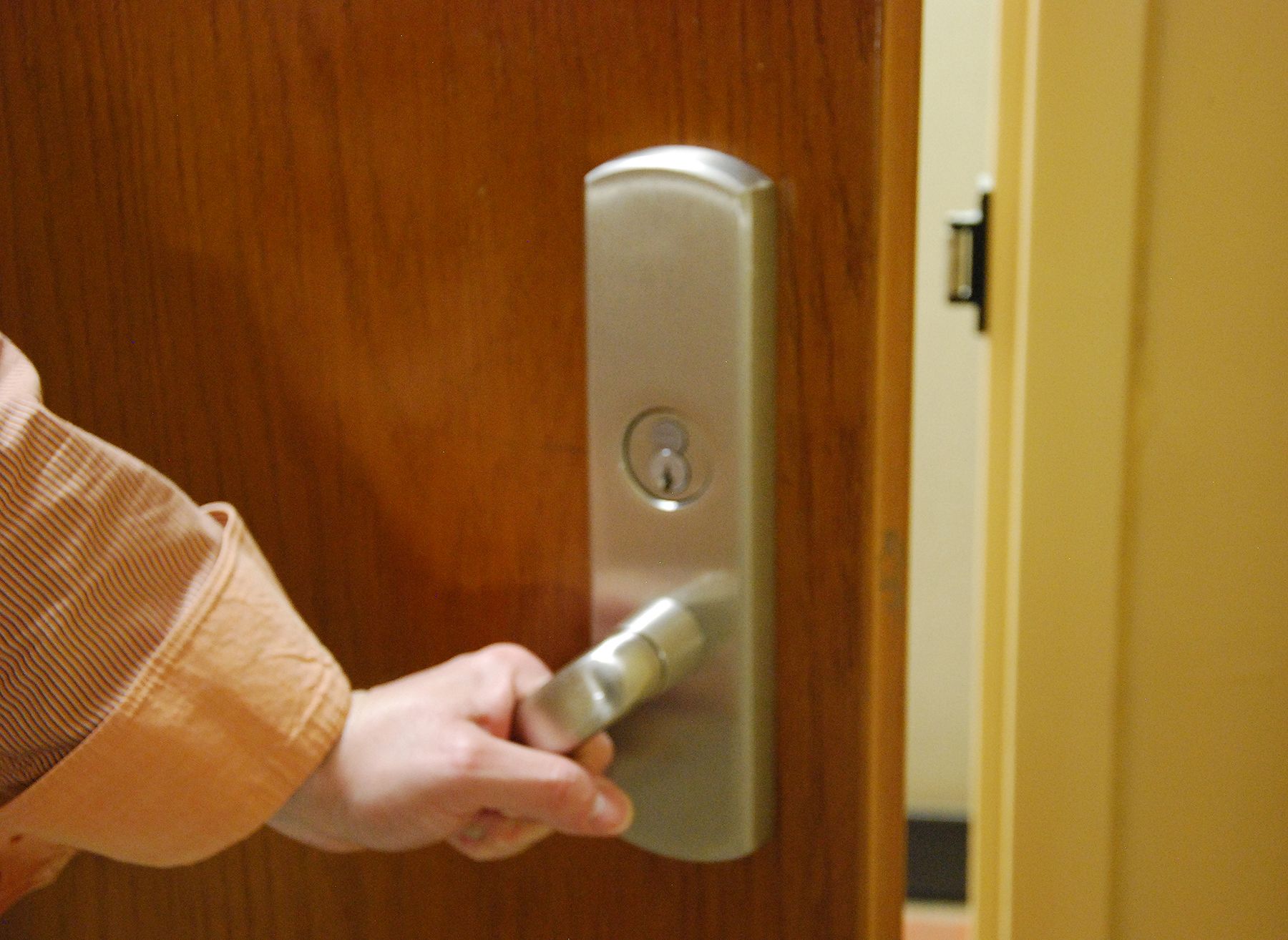Ten years ago I wrote my very first Decoded article, and the column has run continuously since December of 2010. Back then, I had no idea that I would have 10 years’ worth of topics to write about, but here we are.
This post was published in Door Security + Safety
.

Changes related to allowable force have been made to the 2021 editions of the model codes adopted in most US states – the International Building Code (IBC), International Fire Code (IFC), and NFPA 101 – Life Safety Code. The approved proposals separate the limitations for the force used to open a door, from the force used to operate the hardware. This has helped to align the model codes with the 2017 edition of ICC A117.1 – Standard for Accessible and Usable Buildings and Facilities, but a conflict with the 2010 ADA Standards for Accessible Design remains.
Opening Force for Doors
 The opening force requirements stated in these model codes have not changed, and the requirements are generally consistent with the accessibility standards used in most states across the US. The model codes reference ICC A117.1 as the standard for accessibility, and the ADA Standards establish design requirements for the construction and alteration of facilities subject to the Americans With Disabilities Act (ADA). Some states have adopted the ADA Standards instead of ICC A117.1, or have created their own standards. In jurisdictions where more than one set of standards apply, the most stringent requirements must typically be met. Note that the requirements in this article for doors would also apply to gates that are required to comply with the applicable accessibility and/or egress codes.
The opening force requirements stated in these model codes have not changed, and the requirements are generally consistent with the accessibility standards used in most states across the US. The model codes reference ICC A117.1 as the standard for accessibility, and the ADA Standards establish design requirements for the construction and alteration of facilities subject to the Americans With Disabilities Act (ADA). Some states have adopted the ADA Standards instead of ICC A117.1, or have created their own standards. In jurisdictions where more than one set of standards apply, the most stringent requirements must typically be met. Note that the requirements in this article for doors would also apply to gates that are required to comply with the applicable accessibility and/or egress codes.
Interior Non-Fire-Rated Doors
To manually open a non-fire-rated swinging door, the opening force for pushing or pulling the door is limited to 5 pounds. This is consistent across the model codes and accessibility standards, although the IBC applies the 5-pound maximum force regardless of whether the door has a door closer, and NFPA 101 applies it only to doors without closers. NFPA 101 also includes an exception for existing doors in existing buildings and limits the opening force for those doors to 50 lbf, maximum.
ICC A117.1 exempts doors or gates required to be equipped with panic hardware, break-away features, or other factors requiring higher opening force for safety reasons, and defaults to the scoping provisions adopted by the appropriate administrative authority, but the model codes and the ADA Standards don’t include a similar exception. That means that in most cases, 5 pounds is the maximum allowable force for interior non-fire-rated swinging doors.
Sliding and folding doors are not required by the I-Codes or NFPA 101 to open with 5 pounds of force; they are considered “other” doors by the model codes (see below). However, the accessibility standards limit the opening force for interior sliding and folding doors to a maximum of 5 pounds. This limitation would apply in most jurisdictions if the sliding or folding door is part of an accessible route or is otherwise required to meet the accessibility standards.
Exterior Doors, Fire Doors, and Other Doors
The maximum opening force for exterior doors and fire door assemblies is not limited by the accessibility standards, but the model codes do address these doors. For “other” manually-operated swinging doors – including exterior doors and fire doors, the 2021 editions of the IBC and NFPA 101 allow a maximum of 30 pounds to set the door in motion, and 15 pounds to move the door to the fully-open position. Prior editions of the model codes include a limit of 15 pounds to release the latch, but in the 2021 editions, the operable force for releasing the latch is addressed separately.
NFPA 80 – Standard for Fire Doors and Other Opening Protectives, addresses the importance of adequate spring power for closers on fire doors with a section in Annex A. The closing force (which in most cases affects the opening force) must be enough to overcome the resistance of the latch, but excessive closing force could make the doors difficult for some building occupants to open. Door closers are typically classified by spring size, with a higher number (for example, size 6) signifying more closing force. NFPA 80 recommends a minimum size 4 closer for exterior fire doors, and a minimum size 3 closer for interior fire doors, with an increase of one or two spring sizes where necessary because of door width, abnormal air pressures, or other factors.
The spring sizes addressed in NFPA 80 are recommendations to help ensure that fire doors close and latch properly. For opening force, fire doors must comply with the limitations from the model codes for “other doors”, addressed in this section – a maximum of 30 pounds of force to set the door in motion, and 15 pounds to move the door to the fully-open position.
Note: Although sliding and folding doors are considered “other doors” by the model codes, with opening force limited as described in this section, the 5-pound limit of the accessibility standards will apply if the doors are required to comply with the accessibility standards.
Automatic Doors
The force needed to open automatic doors manually is addressed in the model codes as well as in the standards that apply to automatic doors. For most automatic swinging doors operated by a knowing act, the model codes require compliance with BHMA A156.19 – Standard for Power Assist and Low Energy Power Operated Swinging Doors. This standard limits the manual opening force for these doors to 30 lbf to set the door in motion and 15 lbf to fully open the door. This is more restrictive than the model codes, which reference a maximum force of 50 pounds to set power-operated doors in motion manually.
Full-powered automatic pedestrian doors, commonly seen on the entrance to a grocery store, as well as low-energy operators actuated by a sensor (not by a knowing act) must comply with BHMA A156.10 – Standard for Power Operated Pedestrian Doors. This standard requires automatic doors with a break-away device to break out with a maximum of 50 lbf. When these doors are in “break-out mode” they must not be able to operate automatically.
Measurement Procedure
Various types of force gauges are available, with a range of price and accuracy. The specified locations for measuring the opening force vary slightly between the codes and standards. The I-Codes and NFPA 101 state that the force shall be applied at the latch side of the door. The Guide to the ADA Standards, published online by the United States Access Board, recommends that the gauge be placed directly above the operable door hardware (for example, the lever handle) about 2 ½ inches from the latch edge of the door.
ANSI/BHMA A156.4, Standard for Door Controls – Closers, includes a set of guidelines for measuring the opening force. The location to apply the force gauge is located on the push side of the door, on the horizontal center line of the push plate or lock trim, at 1 inch from the latch edge of the door. After opening the door so the latch is clear of the strike and the door is slightly off the stop, the door is gradually pushed open with the force gauge, to a point where the push side of the latch stile reaches the 70-degree point of the door swing. BHMA A156.10 and A156.19 also establish the point 1 inch from the latch edge for measuring break-away force or manual opening force for automatic doors.
The Commentary edition of ICC A117.1 also includes recommendations for measuring opening force. For swinging doors, the force is to be applied perpendicular to the door at the actuating device or 30 inches from the hinge edge of the door – whichever is the farthest from the hinge. For sliding or folding doors, the force is applied parallel to the door at the door pull or latch. Force is applied gradually so that the applied force does not exceed the resistance of the door. The Commentary also discusses the potential effects of air-pressure differentials on door opening force.
Operable Force for Door Hardware
 The changes made to the 2021 model codes align the operable force requirements of these publications with ICC A117.1, but also perpetuate a conflict with the 2010 ADA Standards for Accessible Design. Prior to this edition of the ADA Standards, the maximum operable force for door hardware was not specified by the accessibility standards. With an editorial change, the ADA section on operable parts became applicable to door hardware, including a limit of 5 pounds of force to operate the hardware used to unlatch the door. This edition of the standards became effective in March of 2012.
The changes made to the 2021 model codes align the operable force requirements of these publications with ICC A117.1, but also perpetuate a conflict with the 2010 ADA Standards for Accessible Design. Prior to this edition of the ADA Standards, the maximum operable force for door hardware was not specified by the accessibility standards. With an editorial change, the ADA section on operable parts became applicable to door hardware, including a limit of 5 pounds of force to operate the hardware used to unlatch the door. This edition of the standards became effective in March of 2012.
The 2017 edition of ICC A117.1, previously silent on the operable force for door hardware, was modified to be consistent with the BHMA standards for locks and exit devices, as well as UL 305 – Standard for Panic Hardware. ICC A117.1 established the limits as 15 pounds maximum to unlatch hardware operated with a pushing or pulling motion – panic hardware, for example, and 28 inch-pounds for hardware operated with a rotational motion, like a lever handle.
 The operable force limitations of ICC A117.1 have been included in the 2021 editions of the I-Codes and the Life Safety Code. (NFPA 101 also applies the 15-pound limit to hardware that operates by sliding, in addition to pushing or pulling.) The force limitations of ICC A117.1 and now the model codes continue to be in conflict with the 5-pound limit established by the ADA Standards.
The operable force limitations of ICC A117.1 have been included in the 2021 editions of the I-Codes and the Life Safety Code. (NFPA 101 also applies the 15-pound limit to hardware that operates by sliding, in addition to pushing or pulling.) The force limitations of ICC A117.1 and now the model codes continue to be in conflict with the 5-pound limit established by the ADA Standards.
It’s unclear when or how this conflict will be resolved, but in the meantime, it’s something to watch out for – especially in states like California where the ADA Standards are used for accessibility instead of ICC A117.1. There have been projects where the 5-pound limit on operable force has been enforced, resulting in exit devices being replaced in the field with panic hardware that operated with 5 pounds of force or less. Consult your adopted codes and standards and/or the local code officials to determine the requirements for your project’s jurisdiction, and your preferred hardware manufacturers to understand the available options.
You need to login or register to bookmark/favorite this content.





Great article! Not sure how I missed it earlier. It was very disheartening to see that that the 2021 CBC 11-B was not updated to match A117. I had even filed an official Comment during the code adoption comment period. There is so much documentation behind the suggested door force weights! The California State Architect (DSA’s) continued stance on enforcing 11B-309.4 despite the potential health risks just makes no sense.